AutoCAD basic creation and editing
Last updated: 2025-10-17
Total video time: 28:31
There are several tools available in Civil 3D that are intended for basic geometry object creation. These basic objects can either be an end product such as with a standard detail layout or they can be used as a foundation from which to create Civil 3D objects. This section will focus on using basic Line, Polyline, 3D Polyline, Rectangle, Curve and Circle tools along with basic Object Snap settings to create geometry for a standard detail drawing.
 Osnap & Line
Osnap & Line
Exercise files: acad-data-c3d20.zip
Start with acad-basc-creat-edit-begin.dwg
Line
One of the most basic geometry objects available is the Line. In Civil 3D, a single Line has two vertices with independent locations and elevations. The Line is often used as a starting point or guide by which other objects are laid out.
- Open acad-basc-creat-edit-begin.dwg
- Ribbon > Home tab > Draw panel > Line icon > Create Line
 (l Enter for command line option)
(l Enter for command line option)- Specify first point
- Left-click
- Specify next point
- Left-click
- Specify first point
- Enter
- Activate ERASE command: eEnter
select lines
Enter
Info: Another option for erasing objects is to select an object and press the delete key.
Info: Keying Enter immediately after a command is finished executing will repeat the same command.
Info: Keying Spacebar executes an active command the same way as keying Enter
Object snaps
When laying out object geometry or specifying a location when prompted in a command, it is often helpful to be able to reference existing object geometry. The object snap tool is built for just that. When Object Snaps are turned on (as a system variable) and you are prompted to specify a location within a command you can "snap" to the exact point desired based on the type of Object Snap turned on simply by moving the cursor within an Object Snap tolerance distance from that point. There are multiple ways to turn on Object Snaps for either "one-time" use or to remain on until turned off. We will cover these and other uses of Object Snaps in a later training module. This section is intended to show what Object Snaps are and provide a few examples of their use.
- Continue working in acad-basc-creat-edit-begin.dwg
- Status Bar > right-click Object Snap icon
- Endpoint: checked
- Center: checked

- Status Bar > right-click Object Snap icon
- Object Snap Settings
- Object Snap On = checked
OK
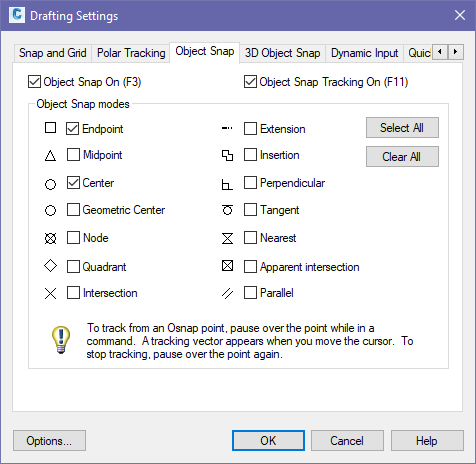
- Object Snap Settings
- Ribbon > Home tab > Draw panel > Line icon > Create Line
- Move cursor near bottom endpoint of red guiding line on left side of Section A-A
- Observe Endpoint Object Snap glyph appear
- Left-click
-
Move cursor near bottom endpoint of red guiding line on right side of Section A-A
-
Left-click
-
- Esc to end command
-
Tip: A common theme you will notice in Civil 3D is that there are multiple ways to access the same commands. Toggling Object Snaps on via Object Snaps Settings vs the F3 hotkey is only one example. With experience you will find the personal workflows you are comfortable with, thus reducing the some of the complexity of Civil 3D.
Info: F3 is a "hotkey" that will toggle Object Snaps on/off
 Polyline
Polyline
Start with acad-basc-creat-edit-begin.dwg
A Polyline is arguably one of the most versatile basic AutoCAD drawing objects. It can be edited in many ways including joining multiple linear geometry objects to one, adding/removing vertices, adding/removing curves and more. In addition, many Civil 3D objects can be created from a Polyline, thus allowing you to set geometry in place using the simpler Polyline object then generate more powerful objects necessary for Civil 3D workflows. This section focuses on basic Polyline creation. It should be noted that when adding elevation data to your objects, a Line can have different elevations at start and end vertices, while a Polyline can have only one elevation for all vertices.
- Continue working in acad-basc-creat-edit-begin.dwg
- Ribbon > Home tab > Draw panel > Line icon > Create Line
- left click below SECTION B-B
- left click at a higher point to the right of the first
- left click to create to create a peak shape with the line
- esc
-
Ribbon > Home tab > Draw panel > Polyline


Info: PL is a command alias that will activate the Polyline command. A command alias is an alternative to activating a command from the Ribbon or typing the full name of the command on the command line. Simply begin typing any command alias when your drawing area (i.e. Model space) is active to call it up on the command line
- Follow the command prompts and create a polyline directly below the line created in the last step.
- Confrim in the properties of the polyline that the elevation values are the same on each vertex
- E Enter for the ERASE command
- select the lines and polyline
- spacebar to exit command
- Check to be sure Endpoint and Center object snaps are on.
- Command Line > PL spacebar
- Move cursor near red guiding circle on left side of Section A-A
- left click
- Move cursor near red guiding circle on just to the left of of Section A-A
- left click
- Mid-command option: A
- Enter
- Move cursor near endpoint of subgrade Line
Left click
Enter
- Move cursor near red guiding circle on left side of Section A-A
- Ribbon > Home tab > Draw panel > Polyline
- Begin drawing Polyline border using outermost guiding circles
- Command line prompt: Close
 3D polyline & rectangle
3D polyline & rectangle
Start with acad-basc-creat-edit-begin.dwg
3D Polyline
A 3D Polyline behaves in many ways the same as a Polyline. The chief difference is that a 3D Polyline can have different elevations at each of its vertices. Having multiple vertex elevations assigned ahead of time can be useful when creating a Civil 3D object such as a Feature Line, Surface Breakline, or Pipe Network from a 3D Polyline.
-
Continue working in acad-basc-creat-edit-begin.dwg
-
Select Polyline border
-
Properties palette > expand Geometry > Elevation = 100
-
Cycle Current Vertex
-
Observe same elevation for all vertices

-
-
Delete
-
Ribbon > Home tab > Draw panel > Draw dropdown > 3D Polyline button
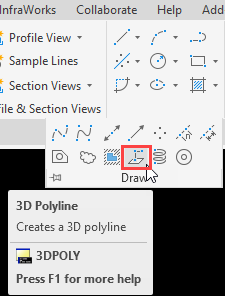
-
Begin drawing 3D Polyline border using outermost guiding circles
-
command line: C
-
Enter
Info: 3DPOLY is a command alias that will activate the 3D Polyline command. A command alias is an alternative to activating a command from the Ribbon or typing the full name of the command on the command line. Simply begin typing any command alias on the command line to access the associated command.
-
Select 3D Polyline > Properties palette > expand Geometry > Elevation = 100
-
Cycle Current Vertex
-
Observe different elevation for other vertices
-
These vertex elevations can be manually changed within the Properties palette.
-
Rectangle
The Rectangle command creates a closed Polyline with rectangle geometry. This simplifies the creation of a Polyline using the common rectangle shape.
- Continue working in acad-basc-creat-edit-begin.dwg
- Select 3D Polyline border
- delete
- Ribbon > Home tab > Draw panel > Rectangle button

- Specify first corner
- Snap to upper left guiding circle
- Specify second corner
- Snap to lower right guiding circle
- Specify first corner
- Spacebar
- Repeat the last steps around "6" text on left side of drawn objects
- Command line: RECT Enter
- Snap to guiding circle around "6" text on right side of drawn objects
- D
- Enter
- 2.8
- Enter
- 11.6
- Enter
- Move cursor to upper right quadrant relative to Rectangle starting corner
- Left-click
 Curve & Circle
Curve & Circle
Start with acad-basc-creat-edit-begin.dwg
Curve
The Curve command includes several variations that use existing reference objects (i.e. tangent Lines) to create single radius, compound, or reverse curves. The object created is referred to as an Arc. The curve command can be helpful when laying out geometry from which to create a smart Civil 3D object.
- Continue working in acad-basc-creat-edit-begin.dwg
- Ribbon > Home tab > Draw panel > Curve flyout > Create Curve on Two Lines
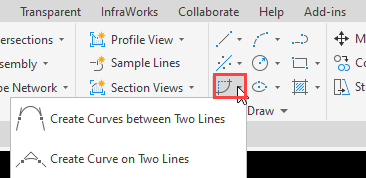
- Select edge of paved median shoulder (Section A-A) as first tangent
- Select left edge of asphalt concrete hatch boundary as second tangent
- Radius: 3
Enter
- Radius: 3
- Ribbon > Home tab > Draw panel > Curve flyout > Create Curves between Two Lines
- Select one Section B-B Median Foreslope Line as first tangent
- Select other Section B-B Median Foreslope Line as second tangent
- R
- Enter
- Specify Radius: 20 Enter

- R
Circle
The Circle command creates an object with circular geometry. Civil 3D refers to the object as a Circle. If a Circle object is trimmed, it becomes an Arc object. Several options are built into the command from which to dictate the radius and location of the Circle.
Continue working in acad-basc-creat-edit-02.dwg
-
Ribbon > Home tab > Draw panel > Circle flyout > Center, Radius
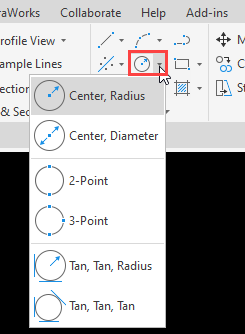
-
Ensure Center Object Snap is toggled on: F3
-
Pan and Zoom to Plan View, R3-4 signage
-
Move cursor over existing signage Arcs to activate Center Object Snap glyph
-
Left-click
-
Specify radius of circle: 2.4
-
Zoom Extents

 Object Selection
Object Selection
Start with acad-basc-creat-edit-02.dwg
In order to direct commands or apply edits to an object, the objects must be selected. In many cases this can be either before or after a command is activated. This is referred to as "pick first" or "pick last". Selecting an object is also a way to gather information about the object via the Properties palette. Objects can be selected using a variety of methods. In this section we will cover simple cursor selection, Window, Crossing, Lasso, Fence and Quick Selection. We will also cover ways to deselect, append and edit the current selection without need to start your selection over from scratch.
Properties palette population
When the Properties palette is open, selecting an object or group of objects will populate the Properties palette with object information common to the entire selection.
- Open acad-basc-creat-edit-02.dwg
- Methods for activating the Properties palette
- Command line > PROPERTIES
- Ribbon > Home tab > Palettes panel > Properties

- Ctrl + 1
- Select an object > right-click > Properties
- esc to deselect
Cursor PickBox selection
- Continue working in acad-basc-creat-edit-02.dwg
- Move cursor PickBox over any object geometry in Model space
- Left-click to select object
- esc to deselect
- Move cursor PickBox over any object geometry in Model space

Left to Right Window Select
All objects completely enclosed by a left to right window selection will be included in the Selection Set. Objects to be selected are highlighted white in a blue background.
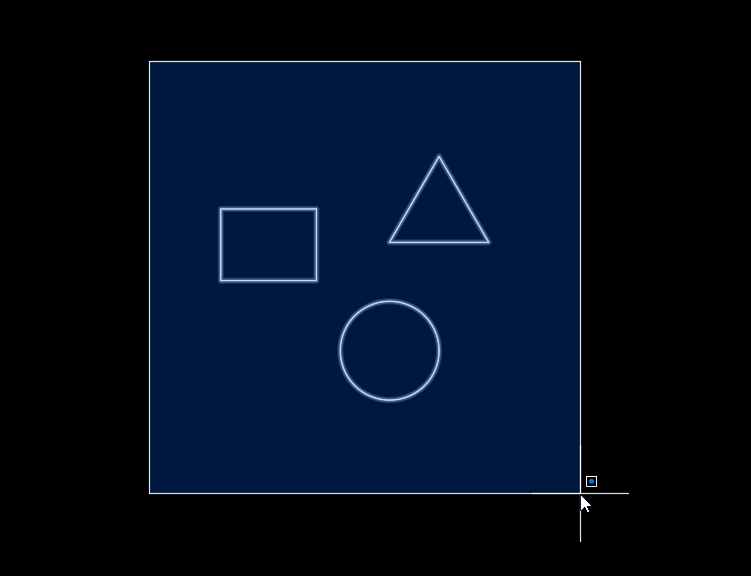
- Continue working in acad-basc-creat-edit-02.dwg
- Move cursor left of desired object(s)
- Left-click to activate Window Selection
- Release mouse button
- Move cursor right of desired object(s)
- Left-click to specify selection area
- esc to deselect
Right to Left Crossing Window Select
All objects enclosed or crossed by a right to left crossing window selection will be included in the Selection Set. Objects to be selected are highlighted white in a green background.
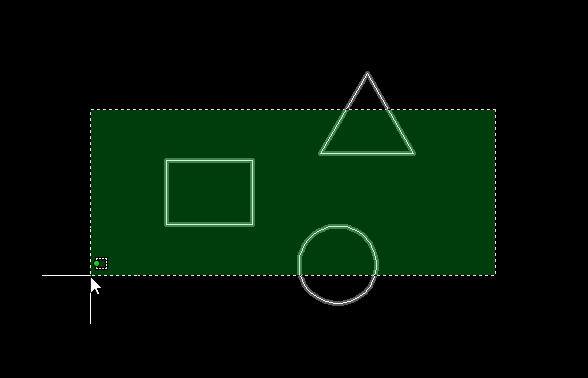
- Continue working in acad-basc-creat-edit-02.dwg
- Move cursor right of desired object(s)
- Left-click to activate Crossing Selection
- Release mouse button
- Move cursor left of desired object(s)
- Left-click to specify selection area
- esc to deselect
Fence Select
All objects crossed by a fence selection path will be included in the Selection Set. A fence can have any number of vertices in any direction. Objects to be selected are highlighted white.
- Continue working in acad-basc-creat-edit-02.dwg
- Move cursor to desired location of Fence
- Left-click to activate Selection
- Command Line > F
- Enter
- Left-click to create additional Fence path vertices
- Enter
Esc
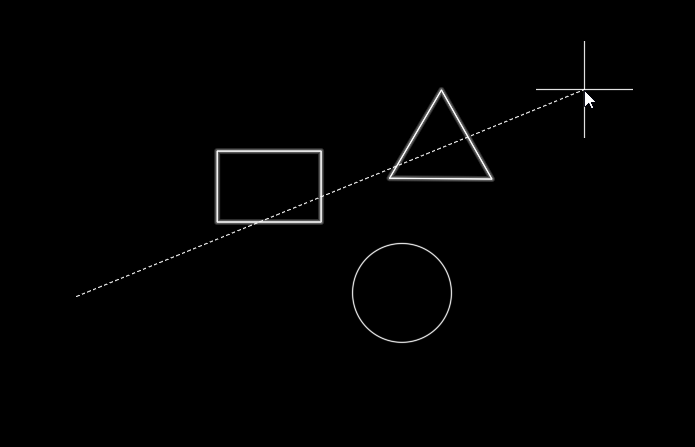
- Left-click to activate Selection
Left to Right Window Polygon Select
Similar to the Left to Right Window Selection, all objects completely enclosed by a Left to Right Window Polygon Selection will be included in the Selection Set. Objects to be selected are highlighted white in a blue background.
- Continue working in acad-basc-creat-edit-02.dwg
- Move cursor to desired initial vertex of Window Polygon
- Left-click to activate Selection
- Command Line > WP
- Enter
- Moving clockwise, Left-click to create successive Window Polygon vertices
- Enter
Esc to deselect
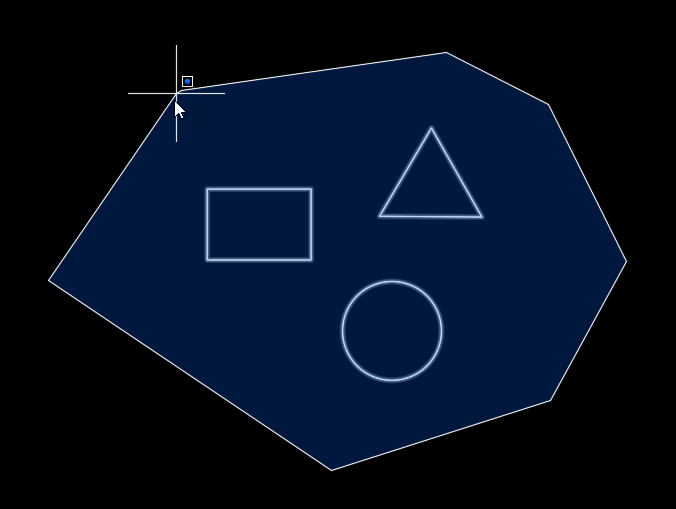
- Left-click to activate Selection
Crossing Window Polygon Select
Similar to the standard Right to Left Crossing Window Selection, all objects at least enclosed or crossed by a Right to
Left Crossing Polygon Selection will be included in the Selection Set. Objects to be selected are highlighted white in a green background.
- Continue working in acad-basc-creat-edit-02.dwg
- Move cursor to desired initial vertex of Window Polygon
- Left-click to activate Selection
- Command Line > CP
- Enter
- Left-click to create successive Window Polygon vertices
- Enter
Esc to deselect
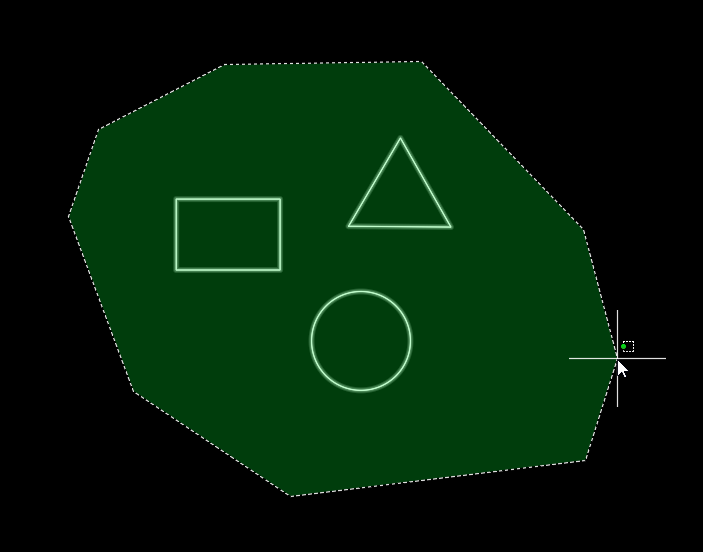
- Left-click to activate Selection
Lasso Select
Similar to both standard Window/Crossing or Polygon Window/Crossing Selection, a Lasso selection can be applied either clockwise or counter-clockwise. Objects to be selected are highlighted white.
- Continue working in acad-basc-creat-edit-02.dwg
- Move cursor to desired initial start point of Lasso Selection
- Left-click and hold mouse button to activate Lasso Selection
- Move cursor along desired boundary of Lasso Selection
- Release mouse button
- esc to deselect
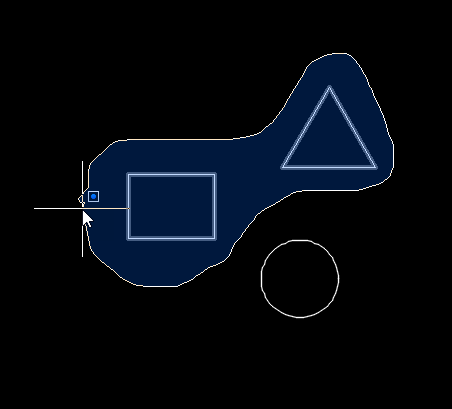
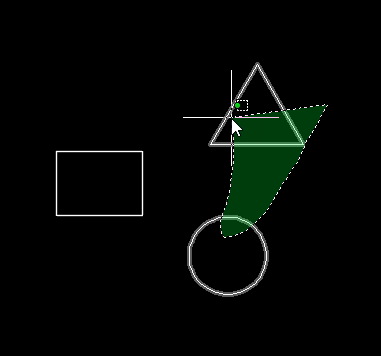
Quick Select
The Quick Select tool allows you to build a selection query based on object properties. The query can either be inclusive (select what is queried) or exclusive (select all but what is queried). The query can also be set to append or replace any current selection set.
- Continue working in acad-basc-creat-edit-02.dwg
- Right-click > Quick Select
- Apply to = Entire drawing
- Object type = Line
- Operator = Select All
- Include in new selection set = checked
- Append to current selection = checked
- OK
esc to deselect

- Right-click > Quick Select
Editing current selection
Once multiple objects are selected, you may wish to remove certain objects from the selection set. To switch selection tools from selecting to deselecting, hold the Shift key while performing the selection in Model Space. A "-" glyph indicating deselection will appear next to the cursor when holding the Shift key and hovering over an object in the current selection set.
- Continue working in acad-basc-creat-edit-end.dwg
- Select multiple objects
- Hold Shift
- Use cursor selection to deselect objects from the selection set
- esc to deselect all

 Grips
Grips
Start with acad-basc-creat-edit-end.dwg
When an object is selected, Grips will be displayed along the object. These Grips make various geometric object edits available. They are generally located at key points along or adjacent to an object (i.e Line endpoints/midpoint or Arc endpoints/midpoint/radius point. To edit an object based on a Grip, click on a Grip or hover over it and choose from available Grip options. There are several advanced object edits that can be performed using grips. Many of these will be covered in a later training module. This section will cover a sample of basic grip functions. This is intended to provide a general understanding of grips as a foundation for further independent exploration.
Line grips
When a Line is selected, three Grips are displayed. The two endpoint Grips allow you move/stretch or lengthen the respective endpoint independently. The midpoint Grip allows you to move the Line with the midpoint as a basepoint, keeping all other geometry properties intact (i.e. length, rotation).
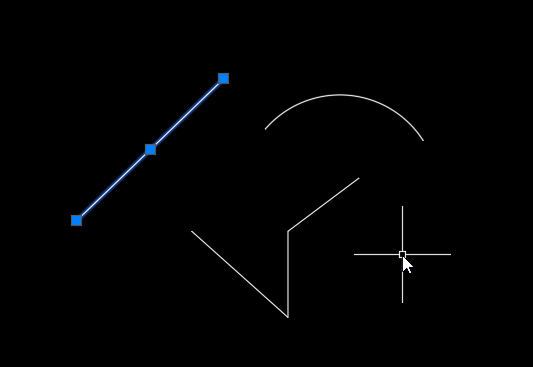
- Open acad-basc-creat-edit-end.dwg
- Select Line representing subgrade
- Left-click endpoint Grip
- Move mouse
- Left-click to place new endpoint
- Hover over endpoint Grip
- Lengthen
- Move mouse
- Left-click to place new endpoint
- Lengthen
- Left-click midpoint Grip
- Move mouse
- Left-click to place line in new location
- esc to deselect
- Left-click endpoint Grip
Arc grips
When an Arc is selected, four Grips are displayed. The two endpoint vertex Grips allow you move/stretch or lengthen the respective vertex independently. The midpoint Grip allows you to change the radius of the arc keeping intact either the location of the endpoint vertices or their alignment with the radius point. The radius point grip allows you to move the arc with the radius point as a basepoint, keeping all other geometry properties intact (i.e. radius).
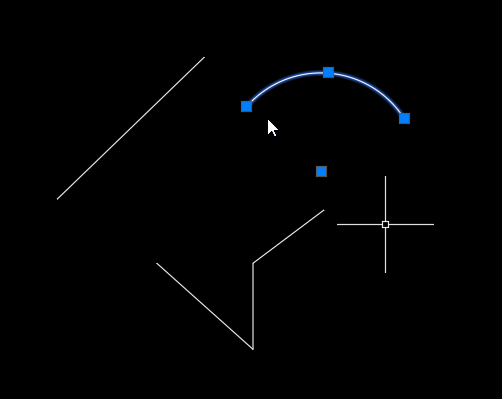
- Continue working in acad-basc-creat-edit-end.dwg
- Select Arc representing median nose
- Left-click centerpoint Grip
- Move mouse
- Left-click to place in new location
- Hover over midpoint Grip
- Stretch
- Move mouse
- Left-click to place new endpoint
- Stretch
- Hover over midpoint Grip
- Radius
- Move mouse
- Left-click to set new radius
- Radius
- Hover over endpoint Grip
- Stretch
- Move mouse
- Left-click to place new endpoint
- Stretch
- Hover over endpoint Grip
- Lengthen
- Move mouse
- Left-click to place new endpoint
- Lengthen
- esc to deselect
- Left-click centerpoint Grip
Polyline grips
When a Polyline is selected, square Grips are displayed at all vertices and dash Grips are displayed at all line segment midpoints. Endpoint vertex Grips allow you stretch (i.e. move) the respective vertex independently or add a vertex adjacent to the endpoint. The midpoint Grip allows you to stretch the line segment, add a vertex between the two adjacent endpoint vertices, or convert the line segment to an arc. When stretching a line segment, the length and rotation geometry of the selected line segment stays intact. Geometry of any adjacent line segments will adjust as necessary. When converting a Polyline line segment to arc, a radius must be specified. A Polyline arc segment can also be converted back to a line segment.
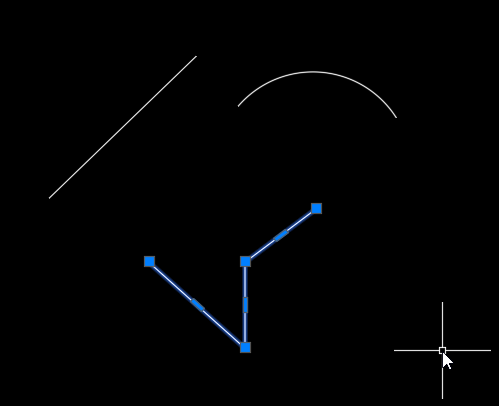
- Continue working in acad-basc-creat-edit-end.dwg
- Select the polyline representing bottom of base course
- Hover over endpoint Grip
- Add Vertex
- Move mouse
- Left-click to place new vertex
- Add Vertex
- Hover over midpoint Grip
- Add Vertex
- Move mouse
- Left-click to place segment in new location
- Add Vertex
- Hover over Polyline line segment midpoint Grip
- Convert to Arc
- Move mouse
- Left-click to place set radius
- Convert to Arc
- Hover over Polyline arc segment midpoint Grip
- Convert to Line
- esc to deselect
- Hover over endpoint Grip
